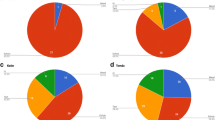Abstract
Michael (1985) identified two types of verbal behavior, topography-based (e.g., speaking or using sign language) and selection-based (e.g., using a symbol board). Sundberg and Sundberg (1990) and Wraikat (1990) compared these systems in terms of the ease of learning object naming (tact) and giving the correct sign or pointing to the correct symbol on hearing the object name (intraverbal). Sundberg and Sundberg (1990) also compared them for the spontaneous development of a new relation, identifying the object when hearing its name (stimulus class formation or equivalence). The results of both studies favored the topography-based system, but in each case some subjects were not verbally skillful enough to learn either system and some learned both too easily to permit a useful comparison. The current study replicated the two previous ones by teaching the same two verbal relations and testing for the emergence of new relations, but adjusted the task to the subject’s level of functioning during the experiment. This was accomplished by varying the number of object relations being learned, and by interspersing already learned tasks with the training of new tasks. As with the earlier studies, topography-based verbal behavior was easier to learn, and led to more new stimulus-class relations than selection-based verbal behavior. These data confirm the relevant theoretical analysis, and have practical implications for a change in current language training practices.
Similar content being viewed by others
References
D’Amato, M. R., Salmon, D. P., Loukas, E., & Tomie, A. (1985). Symmetry and transitivity of conditional relations in monkeys ( Cebus apella) and pigeons (Columba livia). Journal of the Experimental Analysis of Behavior, 44, 35–47.
Lazar, R. M., Davis-Lang, D., & Sanchez, L. (1984). The formation of visual stimulus equivalences in children. Journal of the Experimental Analysis of Behavior, 41, 251–266.
McIntire, K. D., Cleary, J. & Thompson, T. C. (1987). Conditional relations by monkeys; reflexivity, symmetry, and transitivity. Journal of the Experimental Analysis of Behavior, 47, 279–285.
Michael, J. L. (1985). Two kinds of verbal behavior plus a possible third. The Analysis of Verbal Behavior, 3, 2–5.
Mirenda, P. (1985). Designing pictorial communication systems for physically able-bodied students with severe handicaps. Augmentative and Alternative Communication, 1 (2), 58–64.
Sidman, M., Rauzin, R., Lazar, R., & Cunningham, S. (1982). A search for symmetry in the conditional discrimination of rhesus monkeys, baboons, and children. Journal of the Experimental Analysis of Behavior, 78, 23–44.
Skinner, B. F. (1974). About behaviorism. New York: Knopf.
Sundberg, C. T., & Sundberg M. L. (1990). Comparing topography-based verbal behavior with stimulus selection-based verbal behavior. The Analysis of Verbal Behavior, 8, 31–41.
Sundberg, M. L. (1987). Teaching language to the developmental disabled: A course manual. Prince George, B. C.: College of New Caledonia Press.
Trefler, E., & Crislip, D. C. (1985). No aid, an Etran, a Minspeak: A comparison of efficiency and effectiveness during structured use. Augmentative and Alternative Communication, 1 (4), 151–155.
Wraikat, R. M. (1990). Teaching tact and intraverbal behavior to developmentally disabled adults: A comparison of topography-based and selection-based paradigms. Unpublished manuscript, Western Michigan University, Kalamazoo, Michigan.
Author information
Authors and Affiliations
Additional information
Portions of this paper are based on a dissertation submitted by the first author to Western Michigan University in partial fulfullment of the requirements for the Ph.D. degree.
Rights and permissions
About this article
Cite this article
Wraikat, R., Sundberg, C.T. & Michael, J. Topography-based and selection-based verbal behavior: A further comparison. Analysis Verbal Behav 9, 1–17 (1991). https://doi.org/10.1007/BF03392856
Published:
Issue Date:
DOI: https://doi.org/10.1007/BF03392856




